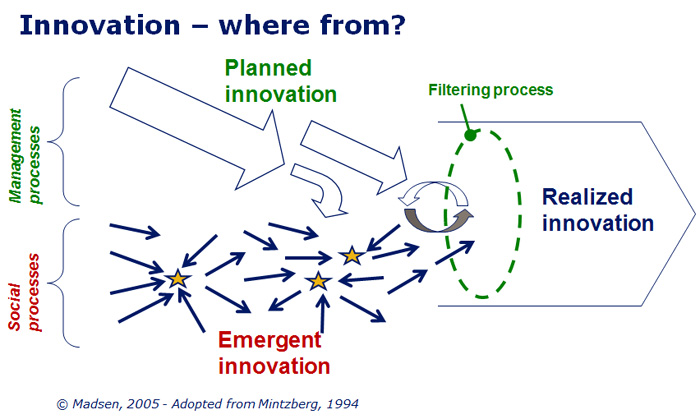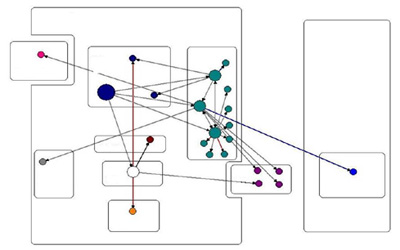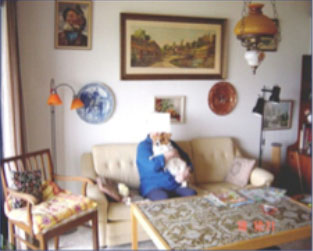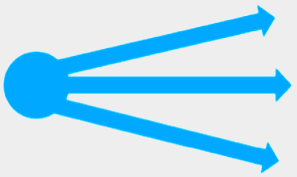
INNOVATION BETWEEN PLANNING AND PLAYING
Here’s my worldview of corporate innovation (see
Articles, 2005). The model displays that innovation is not only a
result of management processes in the organization. It’s also a
result of social processes amongst the employees in terms of the
ongoing discussions about new technologies and new trends, where
many different points of view collide.
In the traditional rational-choice paradigm, innovation is all
about making the best plan, which can out-compete the other
players in the industry. This is of course a dream scenario for
top management: you can plan your way to new opportunities and
growth via a top-down process. You are in control.
But the real world is different: new and innovative initiatives
cannot always be planned; they tend to emerge, bottom-up. Your
role as manager is to intercept the new initiatives and,
retrospectively, define the strategic context for these, so they
can become family members of the corporate strategy. That is far
from the dream scenario for top management, because you are not
really in control here. You should not show people the way to go,
leading ‘from the front’ – rather you should lead ‘from behind’,
giving directions to ensure that the emergent initiatives explore
landscapes which are actually of interest for your business.
The trick is to stage the social bottom-up processes, hereunder
the interplay between the top-down strategic planning and the
emerging creativity of your engineers, so that you can capture the
power and energy from the bottom-up innovation processes; without
stopping the spin of the top (see front page).
Ideas are dynamic knowledge exchanges!
Traditionally, ideas have been seen as products, which could be delivered to an idea box and then ‘sold’ to the organization. In modern idea management, this static view of ideas has been substituted with an understanding of ideas as dynamic exchanges of knowledge; in this view ideas are processes rather than products. This philosophy builds on researchers such as Prof. Van den Ende. The picture below is his graphical illustration of the creation of an idea at Unilever – the boxes represent organizational units, the circles represent individuals, and the lines between represent communications. Van den Ende’s empirical research concludes that the stronger the communication network is, the more successful the idea will be.

The creation of an idea – Kijkuit and Van den Ende, 2010.
This means that your idea management practice should aim for staging the dynamic knowledge exchange, from the first raw thoughts through various phases of maturation and incubation towards formal start-up of a new initiative. The next part is about my experiences over the last years from practicing this modern idea management discipline.
How to stage the bottom-up
innovation
At Novo Nordisk, I have worked with idea management since 2012. When I mention the word ‘idea management’, many business people respond with replies like ‘Oh yes, we also have a portal for that’. They immediately refer to some of the many idea management software tools which exist. I think this understanding totally overlooks the social processes behind bottom-up innovation (see above).
When I in 2012 was asked to design our idea management process, I took advantage of the fact that our device innovation unit was located at one geographical site. Therefore, I started by building up a face-to-face based infrastructure, which could boost a culture of idea sharing.
We organize the capturing of ideas in campaigns, starting with us launching a strategic challenge; in this way we ensure the link between business relevance and employee creativity. The campaigns are concluded with the so-called IdeaLab sessions. These are meetings, where our inventors, the engineers behind the new ideas, pitch their ideas in front of a group of managers. They only have 4 minutes each to present their idea, and they have to present it in management language, so we train people and have rehearsals before the actual event. If the managers like the ideas, we have a process for further maturation of the ideas through workshops and experiments – and they might end up as input for Innovation Briefs, which are our basis for establishing new development projects.
When introduced, the employees liked the new process right from the beginning; because they got feedback and because they got an opportunity to present directly to a panel of managers and experts. However, I quickly learned that if you want to earn respect by management, you have to speak in numbers. So I continuously report numbers such as how many ideas submitted, how many inventors involved, how many workshops, how many patent applications, how many new projects have been started up etc.
In 2014, we added a software platform for online
brainstorming which allows remote departments to join in. In 2015,
we developed the infrastructure further:
• We opened up the process beyond our own unit.
• We included minimum two ideation workshops in each campaign
as a means of staging the networking and knowledge exchange, which
again leads to higher quality ideas.
• We also implemented a peer reviewing system, a bit like the
system used for scientific journals. This improves the quality of
the feedback inventors get – and feedback
is the fuel of the process. But furthermore, I
discovered, it sparks the ideation; the reviewers get inspired to
submit ideas, or the dialogue between the reviewers and the
inventors inspires reformulated or new ideas from the inventors.
In 2016, we are setting up a sandbox unit in the organization. This opens up new opportunities for maturation and incubation of the ideas, in terms of prototyping, technical development etc.
The setup so far has been very successful and
has led to some of our most thrilling projects. The IdeaLab
process even has been appointed as an outstanding
better practice at corporate level. Besides the direct
impact on our innovation portfolio, I have discovered some
positive side benefits from the initiative:
• The staged process makes people communicate
– we bridge between the organizational silos, which else
have scarce contact.
• The competencies by the inventors are upgraded, because we
provide training in how to pitch the idea.
• Also, the initiative has become a canal for the creative
energy from our most entrepreneurial profiles, who constantly get
new ideas. This helps the retention of good, creative people.
looking back
Since 2001, the organization where I work has
gradually transformed our new product development from a
technology based and idea-driven process to a process based on
future scenarios and market understanding, in which technologies
and ideas become means for achieving the strategic goals.
When I started at Device Research & Development 12 years ago,
our innovation was idea driven. Engineers and project managers got
ideas and then they competed for management attention and
resources to get their idea accepted as a candidate for a new
development project.
Then we entered the era of user-centered innovation. We put efforts into understanding the values and unmet needs of the users, by initiating a lot of ethnographic-inspired field studies, where we learned to live inside the customer’s skin.
Few years ago we started implementing strategic innovation. From future scenarios and market insights, we identified business opportunities and then turned these into a portfolio of Innovation Briefs – these are documents, which form the basis of new innovation projects.
I should perhaps add that each of the steps in the development from idea-based to strategic innovation does not exclude the previous. Strategic Innovation neither excludes bottom-up ideas (as you can see from our IdeaLab initiative) nor user studies. However, the “epicenter” of innovation management moves as described above, unfolding these stages of innovation management.
We are proud of this development, since not many companies are able to work strategically with innovation; because it requires that you have your future scenarios and your customer insight studies in place. Therefore, being able to launch a setup for strategic innovation is an achievement in itself. However, as you often see, any solution also creates new problems - in this case:
How do we maintain motivation and ownership?
How do we keep a vein of grassroots innovation open?
How do we keep the ‘front-end’ vibrant?
This is exactly why I have adopted the philosophy of 'leading innovation from behind'!
|
|
Phase 1: A portfolio of ideas for new features which compete for management attention and resources |
|
|
Phase 2: A deep dive into the unmet needs of our users, via ethnographic user research as input for device innovation projects |
|
|
Phase 3: |



